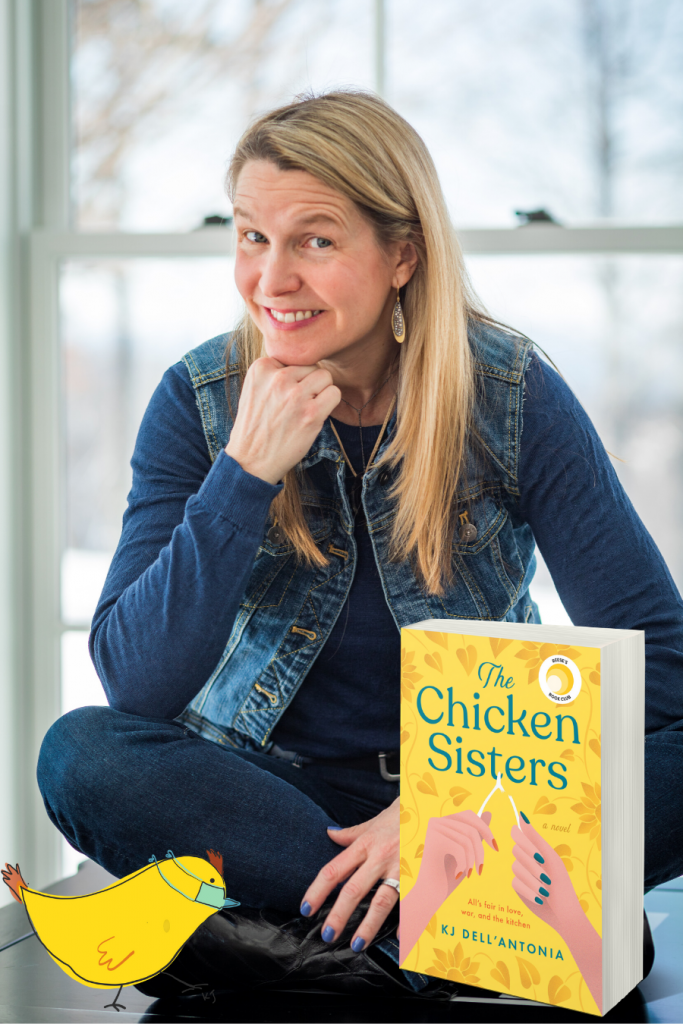
KJ Dell’Antonia is a New England-based writer and author. Her fiction debut, The Chicken Sisters, is a Reese’s Book Club pick and December 2020 Indie Next Pick. It explores the decades-long rivalry between two restaurants in tiny Merinac, Kansas, Chicken Mimi’s and Chicken Frannie’s, as well as between two sisters, Amanda and Mae Moore. Amanda aligns with Chicken Frannie’s, Mae with Chicken Mimi’s, and the two face each other in the reality series, Food Wars.
The Chicken Sisters leverages humor and heart to explore the rivalry and love between these sisters, their extended families, and the restaurants, while also working in a hint of romance and several tasty recipes.
Dell’Antonia also is the author of the nonfiction book, How to be a Happier Parent: Raising a Family, Having a Life, and Loving (Almost) Every Minute, and former lead editor of the New York Times Motherlode blog. She hosts the popular #AmWriting podcast.
A busy schedule, but Dell’Antonia was kind enough to take time to answer a few questions about The Chicken Sisters, writing, reality TV, road graders, and the pull of small towns to many who grow up in one and then decide to return.
How did you come up with the idea for The Chicken Sisters?
My folks are from a small town in Kansas that I visited constantly as kid; I grew up in both Texas and Kansas. The town actually had two chicken restaurants, and that captured my imagination. I know there’s a real story behind the two, although I purposely don’t know what it is.
Instead, I imagined the rivalry between the two restaurants, and wanted it to be as tight and close as possible. And to have a story about real, intense rivalries, it has to be family.
Can you talk about the pull of small town living, especially to those who’ve left one?
Growing up in a small town, I couldn’t wait to get out. I wanted to write about that weird desire most everyone with small town ties has—the idea of ‘Man, I want out,’ and then later, ‘I want to go back.’
I now live in a town of 1,600 in New England. We literally go sit in a school gym and vote on things like whether the town needs a new road grader. It’s wonderful, as there’s nothing red or blue about whether you need a new road grader.
In the book, Amanda remained in the small town and her sister Mae left. Both envy the other for her life choices , and yet need to be right themselves.
You didn’t romanticize the small-town setting, which so many books and movies tend to do. Was that deliberate?
I love a good story about a small town, but it’s always a cute small town in the South or New England, but never the Midwest. I wanted this Kansas town to have its own sort of small-town vibe, without being super-sweet.
The peek behind the scenes at reality TV was a really fun part of the book. Have you been involved in a reality TV show?
Rather randomly and strangely, I was a guest on what was going to be a reality TV show revolving around a surprise party. I saw how the producers would move people around and handle things that went wrong, like the guest of honor getting stuck somewhere. That was my tiny brush with reality TV.
You delve into serious topics, like moving on after a loved one’s death, hoarding, and wanting to outrun your childhood, yet you do it with a sympathetic and appropriately humorous touch. How do you manage that balance?
Everything in life is better dealt with a bit of humor. Who among us hasn’t gotten a phone call with life-changing news? It gives you a heightened appreciation for the absurdity of it all, and how quickly things change. I don’t know how to strike the right balance, other than to keep it from the heart.
You’ve transitioned from writing about nonfiction to writing fiction. How did your previous work help and what remained difficult?
I was a daily deadline journalist for years, and when it’s time to write, it’s time to write. My previous job helped enormously in keeping going and knowing I could get to the end.
Where there was still a learning curve is in putting emotion right on the page. In nonfiction, it’s ‘show, don’t tell’ even more than in fiction. Even in nonfiction essay writing, you’d never say something like ‘I stared, wondering whether to slap him.’ But, you need some of that internal dialogue in fiction. Finding that voice that lets people into the character was kind of a struggle. I had to give myself permission to let those constraints go.
Can you describe the (very helpful) #amwriting podcast?
We (KJ co-hosts #amwriting with Jess and Sarina) love doing it. We talk about writing, invite other writers, and are building a writing community.
If you could form a writing group with three or four people—living or dead, famous or not, writers or not—who might you choose?
Ann Patchett, Jennifer Weiner, and Jane Smiley, with Stephen King and his wife hanging out with us. We’d talk about how they get the writing done.